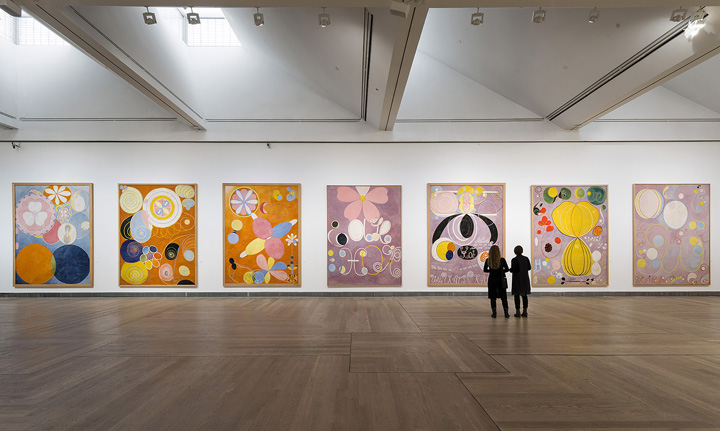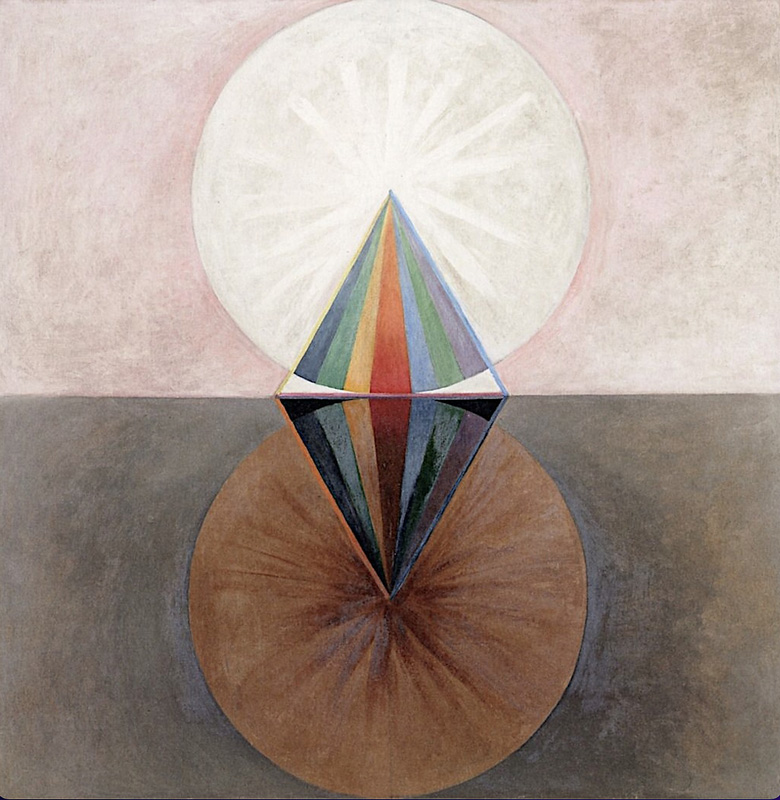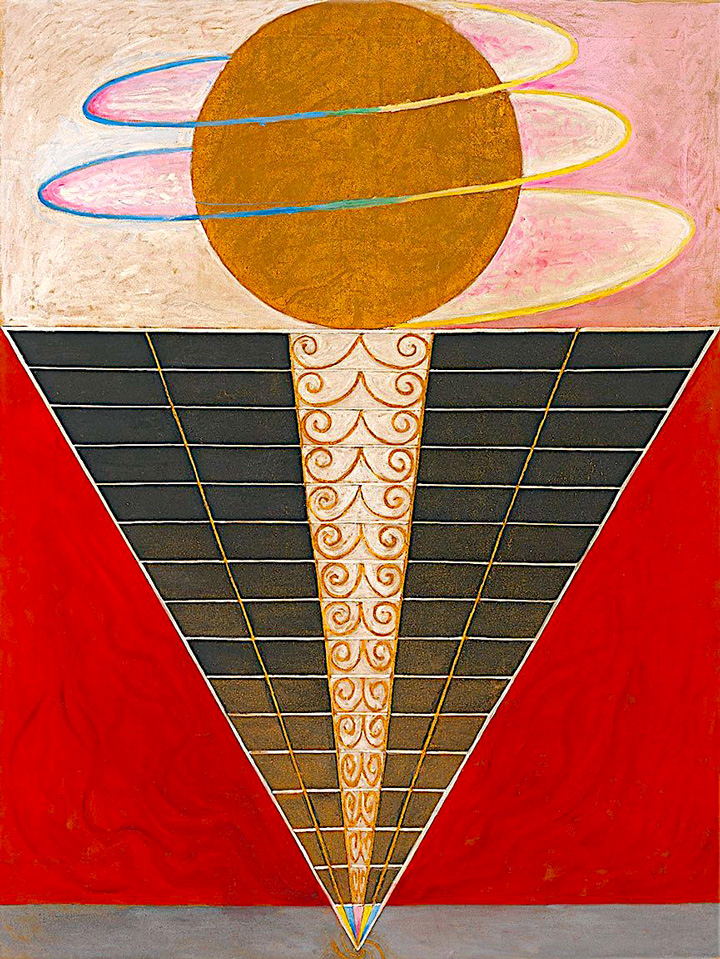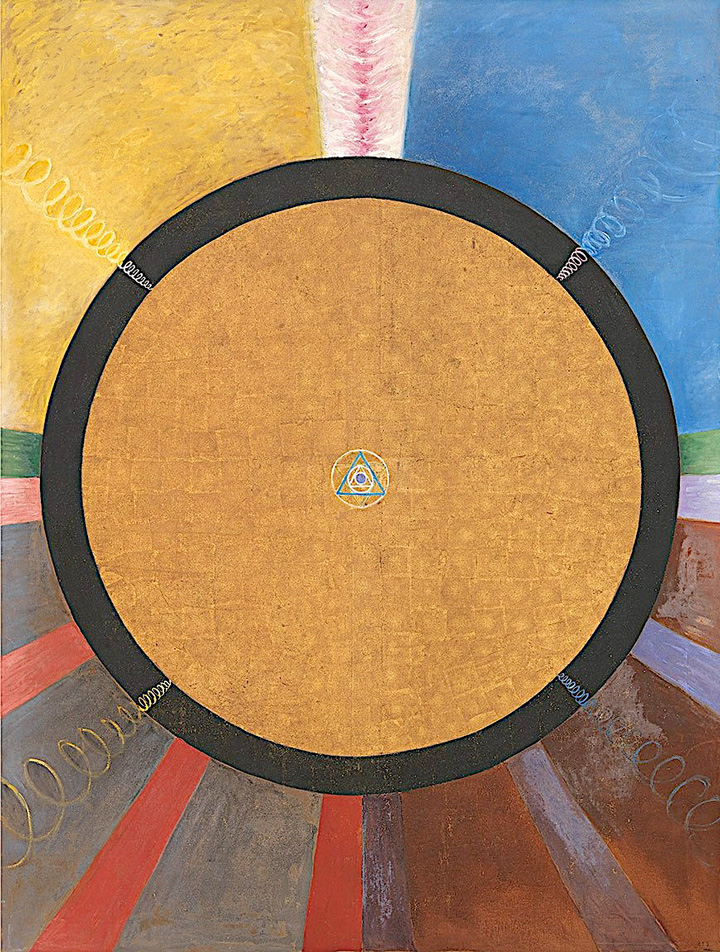Hilma af Klint, first abstract ever
The Swedish painter died nearly eight decades ago in relative obscurity, but you might not realise this if you look her up today. Her paintings, large-scale, vivid masterpieces infused with mysticism and symbolism, seem uncannily contemporary.
Hilma af Klint was born and died in Stockholm (1862-1944). It wasn’t until 1987 that her work came into the light in a groundbreaking exhibition titled The Spiritual in Art at Los Angeles County Museum of Art curated by Maurice Tuchman.
Hilma af Klint’s last wish was that her life’s work, over 1000 paintings and drawings, be hidden for 20 years after her death. The world wasn’t ready for her work and she knew it.
So what was Hilma hiding? No less than a schematic for the spiritual healing of the human race, gifted to her by spiritual masters, bidimensional beings, and translated to her through the seances she conducted as a medium and clairvoyant.
Hilma was a member of a coven, a group of women who called themselves The Five. They documented their communications with the High Masters through automatic drawing and painting. Wilma’s work is startlingly contemporary.

She even beat Kandinsky and is considered the first ever purely abstract artist. Hilma saw her work as a spiritual calling, supercharged with meaning in ways most of her contemporaries struggled to grasp.
She was a true visionary, forward-thinking artist exploring the expressive possibilities of abstraction, decades before Abstract Expressionism movement started after World War II. But even more dazzling than seeing an unknown pioneer of art history being unveiled, are the artworks themselves.
The Swedish abstract artist who conversed with the dead is described as a woman years ahead of her time. Who knew mere colours and shapes could convey so much spiritual fervor?
The voices in her head told Hilma that she would become a great artist. They weren’t wrong.
She was unusual from an early age. Growing up in austere Lutheran Sweden, she studied art at university. A rare feat for a woman. Even less common was her insistence on practising as a professional after graduation. In the face of a society and art world, riddled with extreme misogyny, a quiet, conventional career in portraiture seemed the best she could hope for.

In 1906, Hilma started to receive messages from another world and her life was irrevocably altered. Her visions told her that she was making art for people of the future. She began the construction of an extraordinary series of 1,200 paintings, which she continued until her death in 1944.
With extraordinary subtle colours, her work is still novel, a century later. It’s taken a long time for the art world to catch up with the visionary Swede.
Her biography, by Voss was published in Germany (2020). The author is award-winning art historian, art editor of Frankfurter Allgemeine Zeitung. He taught himself Swedish to decipher a huge archive and decode a mysterious life story.
Hilma saw her work as a spiritual calling, supercharged with meaning in ways most of her contemporaries struggled to grasp. Without knowing it, she was a true pioneer of abstract painting.
Hilma socialised and collaborated with other visionary women, artists and writers, all involved with new philosophies sweeping Europe: spiritualism, Rosicrucianism and theosophy.
Mixing psychology, Christianity and Buddhism, historical fantasy and science fiction, New Age ideals were amazingly popular, particularly among educated women. They used those ideologies to carve themselves new social niches outside the suffocating strictures of church and family.

It was in these new communities that Hilma first spoke with the dead.
Under the direction of experienced mediums, she received missives from higher planes at a staggering rate. Her visions, speaking of secret pasts and a luminous, egalitarian future, drew others to her.
And in this underground of dreamers, Hilma found friends, allies and lovers. Like everything else in her life, the artist’s relationships with women were secretive, intense and suffused with supernatural meaning.
She conceived herself as a mix of two spirits: male Asket and female Vestal. She experienced sexual encounters with friends from a place beyond clear gender relationships.
Elsewhere, she floundered; she was sidelined by male artists and struggled for exhibition space, living in near total anonymity. But Hilma was buoyed by her own self-belief. Her life, like her art, was bold, colourful, self-contained.
The artist was strong-willed, purposeful and confident. Certainly, ahead of her time and perhaps ours too. What’s fascinating, isn’t that Hilma heard voices in a century awash with spiritual fads. It’s that, as far as her genius was concerned, those voices weren’t wrong.
She combined abstraction with spiritualism to create a unique artistic style that pre-dates other abstract painters. Her art was so revolutionary that she asked that it not be shown, out of concern that it would not yet be understood. She even went so far as to place in her will that none of it be publicly exposed until 25 after her death. The world was not ready, she believed, to comprehend her “paintings of the future”.

Why should she be so concerned? Non-objective art had never yet been created. Certainly not by a woman. It was almost impossible, for a female to be an artist, to study under the masters, or to become a member of the male-only academies of Europe. Women had no access to fine art training. Even wives or lovers of well-known artists were shout out from official competitions.
Until recently, Hilma had largely been ignored. But a retrospective at the Guggenheim Museum in New York, “Beyond the Visible” (2019) brought her incredible, colourful work back into the spotlight. Another exhibition, “Swedish Ecstasy” is on view at BOZAR Centre for Fine Arts in Brussels (February-May 2023).
A third exhibition takes place at Tate Modern, London, bringing together the Swedish Hilma af Klint and the Dutch Piet Mondrian. We can admire their distinctive contributions to Abstraction, their shared interest in esoteric beliefs and their deep engagement with the natural world. The show, curated by Bryony Fer, will later travel from England to Kunstmuseum den Haag (Holland).
We know all their names, Kandinsky, Mondrian, Klee, Miro… Art history has written them in stone as the 20th century revolutionaries that removed all recognisable objects from their art to the point that they were completely non-objective. What do they all have in common? They were all men. But this female artist prolifically created non-objective art long before any of them.
Finally, the world has discover Hilma’s extraordinary art. She must be smiling in heaven.
“Klint and Mondrian, Forms of Life”
- Tate Modern,
- London,
- 20 April-3 September 2023
- Kunstmuseum den Haag,
- The Hague,
- 7 October-25 February 2024

